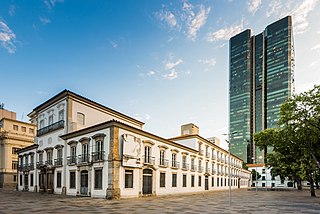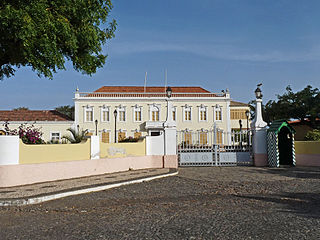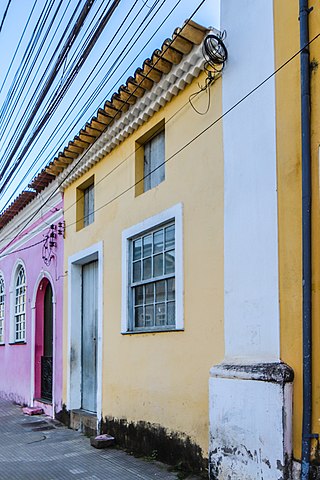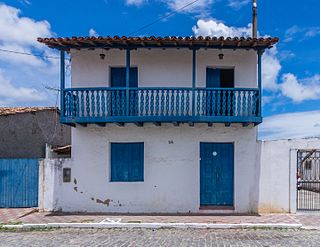
São Filipe is a city on the west coast of the island of Fogo, Cape Verde. It is the capital of the island, and the seat of the São Filipe Municipality. The island's airport, São Filipe Airport, is located on the southeastern edge of the town and the island's port is 4 km north of the center at Vale de Cavaleiros. The town's elevation is 20 meters.

São Cristóvão is a Brazilian municipality in the Northeastern state of Sergipe. Founded at the mouth of the Vaza-Barris River on January 1, 1590, the municipality is the fourth oldest settlement in Brazil. São Cristóvão is noted for its historic city square, São Francisco Square, and numerous early colonial-period buildings. The 3 hectares site was designated a UNESCO World Heritage Site in 2010.

Claridade was a literary review inaugurated in 1936 in the city of Mindelo on the island of São Vicente, Cape Verde. It was part of a movement of cultural, social, and political emancipations of the Cape Verdean society. The founding contributors were Manuel Lopes, Baltasar Lopes da Silva, who used the poetic pseudonym of Osvaldo Alcântara, and Jorge Barbosa, born in the Islands of São Nicolau, Santiago and São Vicente, respectively. The magazine followed the steps of the Portuguese neorealist writers, and contributed to the building of "Cape Verdeanity", an autonomous cultural identity for the archipelago.

Cachoeira is an inland municipality of Bahia, Brazil, on the Paraguaçu River. The town exports sugar, cotton, and tobacco and is a thriving commercial and industrial centre.

Laranjeiras is a municipality located in the Brazilian state of Sergipe. Its population was 30,080 (2020) and covers 162.27 km2 (62.65 sq mi). Laranjeiras has a population density of 180 inhabitants per square kilometer. Laranjeiras is located 19 km (12 mi) from the state capital of Sergipe, Aracaju. It borders the municipalities of Riachuelo, Areia Branca, Nossa Senhora do Socorro, São Cristóvão, Maruim, and Santo Amaro das Brotas, all within the state of Sergipe. The municipality contains part of the Serra de Itabaiana National Park.

The Paço Imperial, or Imperial Palace, previously known as the Royal Palace of Rio de Janeiro and Palace of the Viceroys, is a historic building in the center of the city of Rio de Janeiro, Brazil. The Paço Imperial was built in the 18th century to serve as a residence for the governors of colonial Brazil. From 1808, it was used as a royal residence by King John VI of Portugal as King of Portugal and later also as King of Brazil. In 1822 it became the city palace of the monarchs of the Empire of Brazil, Pedro I and Pedro II, who used it not as a residence, but as a workplace. It was one of the main political centers of Brazil for nearly 150 years, from 1743 to 1889.

The Quinta da Boa Vista is a public park of great historical importance located in the São Cristóvão neighbourhood, in the North zone of the city of Rio de Janeiro, Brazil. The park was part of the gardens of the São Cristóvão Palace, the residence of the Emperors of Brazil in the 19th century and the home of the Zoological Garden of Rio de Janeiro, with over 2000 species of animals. The building of the old palace hosted the National Museum, with collections on natural history, ethnology and archaeology.

São Francisco do Conde is a municipality in the state of Bahia in the North-East region of Brazil. São Francisco do Conde covers 262.856 km2 (101.489 sq mi), and has a population of 40,245 with a population density of 150 inhabitants per square kilometer. It is located 67 kilometres (42 mi) from the state capital of Salvador. According to the Brazilian Institute of Geography and Statistics São Francisco do Conde has the highest concentration of Brazilians of African descent (90%) in Bahia.
Brazilians in Nigeria, Amaros or Agudas consist of the descendants of freed Afro-Brazilian slaves who left Brazil and settled in Nigeria. The term Brazilians in Nigeria can also otherwise refer to first generation expatriates from Brazil.

Museu Municipal de São Filipe is a museum located in the historic centre of São Filipe, on the island of Fogo, Cape Verde. It is located in a sobrado, a colonial town house. The museum was opened on December 13, 2008, by the town president Eugênio Miranda da Veiga.

The Architecture of Cape Verde has different architectural styles in the nation. Unlike the African mainland, Cape Verde was uninhabited until 1461 when the Portuguese arrived, most of the other islands were first inhabited after the end of the 15th century. Its architecture was introduced in the 1460s and has its first origins from Portuguese settlers from the Madeira Islands, after the first arrival of mainland Africans, a bit of African architecture would be elements mainly in rural areas. The Manueline was its first architectural style on the island, it was later followed by Renaissance, Baroque, Pombaline, Early Modern and Modern. It was one of the last in the whole of Africa to introduce architecture late. Cape Verde has one of the richest architecture in the western portion of West Africa, the sub-Saharan portion, the richest probably being Mali.

Funco is a traditional Capeverdean house that originated in Africa.

A loja is a kind of a grocery-bar or a characteristic boutique in Cape Verde, which makes up a subdivision of a Creole lifestyle.

Comércio is a neighborhood of Salvador, Bahia, Brazil. The district served as the port of entry to Salvador from the beginning of the colonial period and later became home to the first planned business district in Brazil. It remains a financial center in the state of Bahia, as well as a municipal transportation hub and tourist destination. Comércio is home to numerous national heritage sites dating from the early colonial period to the 20th century. Comércio as a whole was listed as a national historic district of Brazil by the National Institute of Historic and Artistic Heritage in 2008.

House at No. 4 Rua Ana Nery is a house in Cachoeira, Bahia, Brazil. Its date of construction is unknown but is likely between the end of the 18th century and beginning of the 19th century. The house covers only 122 square metres (1,310 sq ft) and consists of two levels: a ground floor with simple compartments above. The house is noted as a representative example of vernacular Portuguese colonial domestic architecture of the 18th century. It was listed as a historic structure by the National Institute of Historic and Artistic Heritage in 1941. The House at No. 4 Rua Ana Nery is a private residence and may not be visited.

The Former Jesuit House of Prayer is a former residence and cultural center in Salvador, Bahia, Brazil. The building dates to the late 17th century and first functioned as a Jesuit residence, a private residence after the expulsion of the Jesuits from Brazil, a retirement home, and a cultural center. The house is noted for its ornate, stone portal with an elaborate baroque-style pediment. The house was listed as a historic structure by the National Historic and Artistic Heritage Institute in 1938.

Yoruba architecture is an architectural style produced by the Yoruba people of West Africa, dating back to approximately the 8th century. and lasted up to and beyond the colonial period beginning in the 19th century CE.

The Sobrado at Rua Castro Alves, 2 is a Portuguese-colonial era sobrado, or urban manor house, in São Cristóvão, Sergipe, Brazil. It is one of two large two-storey sobrados in São Cristóvão, the other being Sobrado at Rua da Matriz. The sobrado has two stories and cover covers 303.24 square metres (3,264.0 sq ft). It was listed as a historic structure by the National Institute of Historic and Artistic Heritage (IPHAN) in 1943, and became part of the UNESCO World Heritage Site of São Francisco Square in 2010. The sobrado now houses the São Cristóvão office of IPHAN.

The Sobrado at Rua das Flores is a 17th-century Portuguese-colonial era sobrado, or urban manor house, in São Cristóvão, Sergipe, Brazil. It was listed as a historic structure by the National Institute of Historic and Artistic Heritage (IPHAN) in 1943. It is located within the perimeter of the UNESCO World Heritage Site of São Francisco Square. The historian Maria Elisa Carrazzoni includes it among "the most dignified and representative of the residential house in [colonial] Brazil."

The colonial architecture of Brazil is defined as the architecture carried out in the current Brazilian territory from 1500, the year of the Portuguese arrival, until its Independence, in 1822.




















